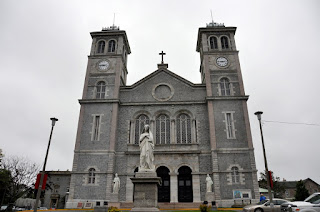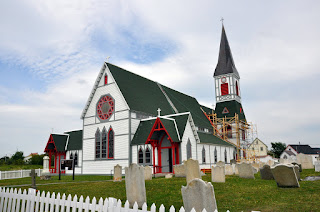Signal Hill is the reception point of the first transatlantic wireless signal by Marconi in 1901. Last year we visited the transmission point for this signal in Nova Scotia. While at Signal Hill we also visited the Queen's Battery and Barracks as well as the Cabot Tower. The fortification of Signal Hill with barracks and a battery began during the French Revolutionary Wars and Napoleonic Wars (1792-1815). The Cabot Tower was completed in 1901 to commemorate Queen Victoria's Diamond Jubilee and also the celebration of the 400th anniversary of Cabot' landing in Newfoundland. From what we were told, the tower served no other purpose.
The Commissariat House was built in 1820 to house the Commissariat Department of the British armed forces that were stationed in Newfoundland. This office was in charge of overseeing the pay and supplies of the British armed forces. Our house tour included the offices and fireproof cash vault as well as the living accommodations for the Assistant Commissary General. After the withdrawal of the garrison in 1871, the house was converted to a rectory for the St. Thomas Church.
Because the Colonial Building is undergoing a full renovation, we were unable to tour the inside. We did get to see the outside, however, and we did learn a few things concerning this building while we were here. The building was constructed of white Irish limestone in 1850. It served as the legislative building for Newfoundland from 1850-1960. When the colony began governing itself in 1832, its first legislative home was a tavern owned by Mrs. Tavers. It was not until 1846 that construction of a true legislative house was begun. That house was Colonial building. We learned that this build eventually had a tunnel built to the Governor's house. It is said that legislative debates were know to turn into full scale riots and the tunnel was to enable the Governor's escape. One of the notable riots occurred on April 5, 1932. This protest turned into a full scale riot and all the windows within the building were broken as well as furniture and doors. We were told there was over $10,000 dollars of damage done on that occasion.
The Confederation Building was a replacement to the Colonial building and was completed in 1960. The entryway is done with large Italian Marble columns to tie themselves into Cabot (Italian), having discovered Newfoundland. In the legislature room all the chairs and desk blotters are all made from seal skins. The desks can be re positioned and are done so to keep the various parties sitting together. Presently the Liberal party has control of the chamber (30 of the 40 seats)which is why you see so many desks on the far side in the picture.
St. John's is home to many historic churches. We have included 3 in the blog, 2 of which we were able to tour inside as well. St. Andrew's Presbyterian Church was completed in 1896. It is the oldest surviving Presbyterian church in the city. The church is built of brick and stone that was imported from Scotland. The church is known as the 'Kirk' . While we were not able to see inside the day we visited, the picture we found online is beautiful. Church Interior
St. John the Baptist Anglican Cathedral is the oldest Anglican church in all of Canada. The parish was founded in 1699 and the church was consecrated as a cathedral in 1850. The interior, including the Casavant Pipe Organ are stunning.
The Basilica of St. John the Baptist was consecrated in 1855. At that time, it was the largest building project to date in the city of St. John's. The church was certainly very contemporary for the time. The Basilica is built of grey limestone and granite that was quarried in Galway and Dublin, Ireland.The alter sacrifice that stands at the front of the sanctuary is sculpted in Carrara marble by the Irish sculptor, John Hogan. It is considered to be his best work and is entitled 'The Dead Christ'.
The Newman Wine Vaults were constructed of stone and brick, are one of the oldest structures remaining in St. John's, and one of the few vaults remaining in Newfoundland. They developed a good and unique port. The unique qualities they were able to achieve with their port, they claim to not know if it came from the rocking of the seas or the maturation in Newfoundland with their climate. We are not really Port wine drinkers, but the sample we tasted made us decide to buy a bottle to take home with us to open on a special occasion. We also learned about the various types of Port, which was new to us.
On our last day in St. John's we counted ourselves incredibly lucky. We went up to Cape Spear as we just had to hike out to the most Eastern part of North America. But that day there were 50 plus mile an hour winds, most likely caused by Hurricane Gaston. The seas that day were 25 feet swells and we were so glad that our ferry departure was yet 2 days away.
Tomorrow we depart on an 18 hours ferry from this wonderful island and its wonderful music, beauty and people. We have been here an entire month, yet we think we would like to return sometime, possible during iceberg season. We are headed towards home and expect to arrive around the 3rd week in September. We will still try to blog along our way home as we plan to stop in some exciting places. We are talking about Alaska once again in 2017. We will see what our coming year brings. Those of you that have followed our Newfoundland adventure, we hope you have enjoyed it. For us it has been wonderful, informative and full of love from the locals.
Newfoundland Trivia: (this is the last trivia post) Newfoundland is the only province in Canada to have its own dictionary. While enjoying our stay on this lovely island we also so enjoyed listening to the locals speak. They have a bit of their own accent and every once in a while you will hear them say a distinctly Newfoundland phrase, that really is so fun to hear. Almost everyone in a a shop calls you sweetheart or love and there are other fun phrases as well. Here are just a few:
Do you want some taken up? - Do you want some supper?
Who knit ya? - Who's your parents?
I just dies at you. - You make me laugh.
Its a mausey day. - A foggy wet day.
I'm just 'bout gutfounded. - I'm very hungry.
And through out our travels I also noticed most say 'good day', with that almost Irish brogue. This has been so very much fun.
While a Newfoundlander will say 'we comes from away', their hospitality and friendliness can not be overstated. We will surely miss this lovely place.
The City of St. John's Newfoundland taken from Signal Hill
An example of their 'Jelly Bean' Houses (their term)
St. John's Newfoundland
The Beautiful Newfoundland DogHe was beautiful and friendly too! Superior Court (built 1904) St. John's Newfoundland Queen's Barracks and Battery Signal Hill, St.John's Newfoundland Cabot Tower Signal Hill, St.John's Newfoundland Commissariat House St. John's, Newfoundland Commissariat House St. John's, Newfoundland Commissariat House St. John's, Newfoundland Colonial Building St. John's Newfoundland Confederation Building St. John's, Newfoundland Confederation Building St. John's, Newfoundland St. Andrew's Presbyterian Church (1896) St. John the Baptist Anglican Cathedral St. John the Baptist Anglican Cathedral St. John the Baptist Anglican Cathedral St. John the Baptist Anglican Cathedral Casavant Pipe Organ St. John the Baptist Anglican Cathedral Basilica of St. John the Baptist Basilica of St. John the Baptist Basilica of St. John the Baptist 'The Dead Christ' by John Hogan Basilica of St. John the Baptist Basilica of St. John the Baptist Newman Wine Vaults St. John's,Newfoundland Newman Wine Vaults St. John's,Newfoundland Cape Spear Lighthouse Newfoundland Cape Spear, Newfoundland Cape Spear, Newfoundland |























































